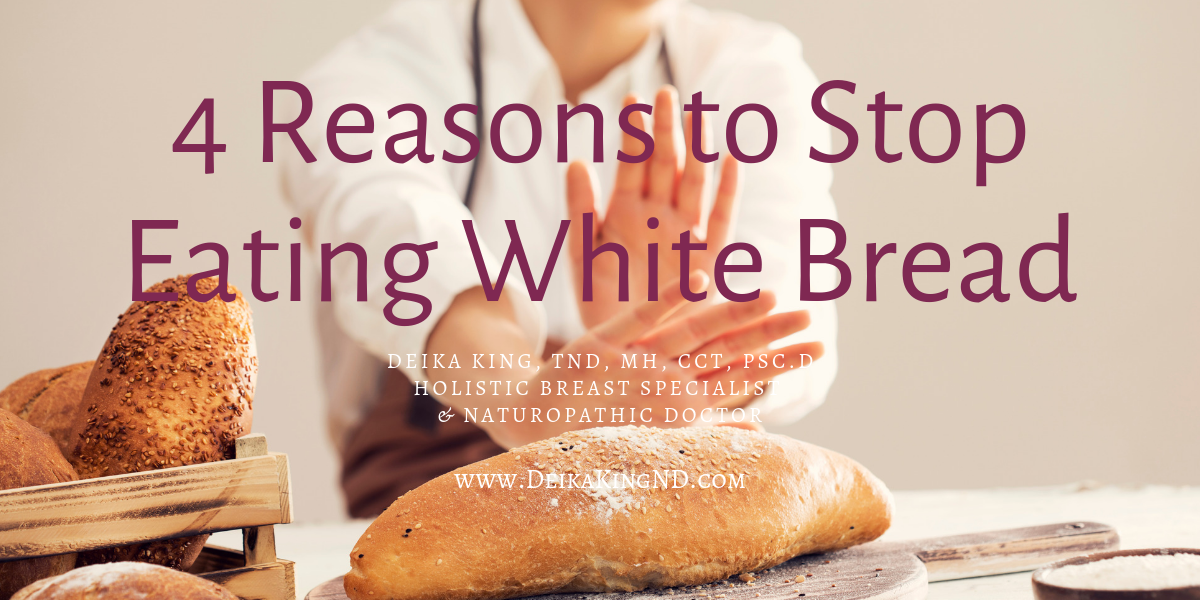There’s nothing wrong with including bread in your diet, right? Well, it turns out it depends on the type of bread it is you’re eating. Whole grain breads provide you with vitamin, minerals, and fiber – they’re a great addition to your diet.
Unfortunately, white bread isn’t just unhealthy, there’s more to it than that. If you’re trying to decide whether to ditch white bread or stay the course, check out these four major reasons.
Reason 1 – No Nutritional Value
To make white bread you first need white flour and unfortunately, white flour has been completely stripped of its nutrients. While manufacturers do enrich white flour with vitamins and minerals, it’s only in small amounts.
The flour used in white bread is mainly starch. On the other hand, whole-grain breads are made from germ and bran. Which are packed with minerals, vitamins, protein, fiber, and healthy fat.
Reason 2 – Full Of Preservatives & Additives
Additives, preservatives like calcium peroxide, ammonium sulfate, mono, DATEM, and diglycerides are all found in the average white bread loaf. White bread has no nutritional value. It’s created with the express purpose of being a filler that is soft and has a longer shelf life.
We talk about foods being whole, living, and dead. You can categorize white bread as a dead food. Other dead foods include processed, junk foods and fast foods. If you want to eat well, choose whole and living foods – that includes lean proteins, fruits, vegetables, and whole-grain breads (and pastas, etc.).
Reason 3 – It Won’t Bring You Satisfaction
While white bread is a filler, what it won’t do is leave you feeling satisfied. White breads are high on the glycemic index and cause a spike in your blood sugar and with that delicious carb rush comes a nasty carb crash. Whereas, you can choose whole-grain breads which release energy slowly – whole-grain bread fills you up more, leaves you feeling fuller for longer, and you don’t need to worry about a nasty carb crash either.
Reason 4 – It Will Lead To Weight Gain
Harvard University says, eating white bread in large quantities is going to lead to weight gain. You may think that eating it is okay because the calorie count is acceptable. The problem is that eating it will lead to craving more of it, which will lead to increased calorie consumption.
When you strip away the benefits of a product just to leave the starchy remains you’re going to go through those spikes in blood sugar and when you crash you will crave. It’s a nasty cycle to get caught up in and eating white bread simply perpetuates it. Without the necessary fiber content, you end up hungrier as white bread leaves your stomach quickly.
You may have chosen to cut white bread from your diet, but you can’t forget about the other sources of white bread that you may still be eating. Bagels count, as do English muffins, baguettes, French bread, and pizza. And they all end up being stored as body fat.
In fact, some researchers are looking into the link between depression in post-menopausal women and refined carbohydrates. Dropping it from your diet is one of the easiest diet and lifestyle decisions you can make, all you need to do is reach for the whole wheat.
If you aren’t convinced and you choose to continue eating white bread then you need to ensure you consume it in the appropriate portions and as part of a healthy, balanced diet. You can use the USDA’s MyPlate to keep yourself on track.
It recommends a diet of 2,000 calories a day and you should only consume 6 oz of grain (each day), to put that into context one ounce is half a slice of bread. However, half of your daily grain count should be whole-grain.
You can also find advice on how to eat well while on a tight budget (https://www.choosemyplate.gov/). Choosing to eat healthy foods doesn’t need to cost more if you plan properly – anyone can improve their lifestyle with a bit of preparation.
Deika King, TND, MH, CCT, PSc.D
Traditional Doctor of Naturopathy Houston
832-422-7271







